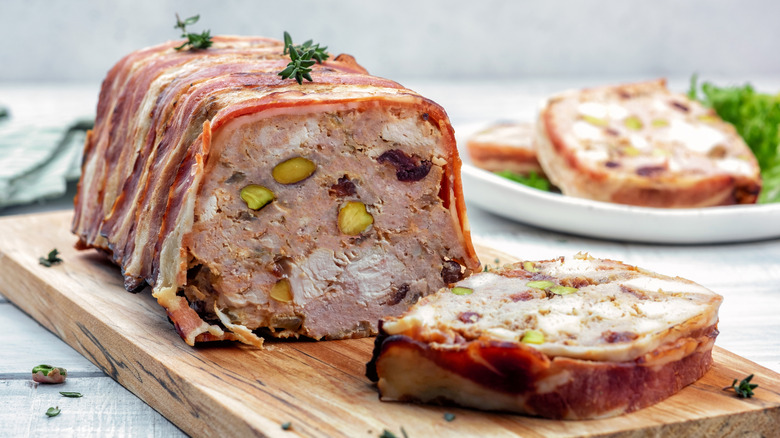What's The Actual Difference Between Pâté And Terrine?
If you've ever seen the two side by side, you might find yourself wondering what the actual difference is between pâté and terrine. Are they cooked in different ways? Do they use different meats, or does one maybe have an extra ingredient that the other lacks? Not always. As a matter of fact, the difference between these two classic French dishes mainly comes down to shape.
Both pâté and terrine are both a type of forcemeat, meat that's ground up and mixed with fat, seasonings and other ingredients. Meat for pâté can be baked in an oven, cooked in a stovetop skillet, or boiled in a water bath. A spreadable pâté, like a duck liver pâté for example, is blended smooth and spreadable, then transferred to pot or jar and served chilled.
A terrine is a type of pâté that's baked in a deep rectangular dish also called a terrine. When removed from the dish, it takes on a loaf shape. The baked terrine has a more solid consistency and can be served sliced. All terrines are pâté, but not every pâté is a terrine.
How pate and terrine are prepared
Pâté is commonly made from pork, the most consumed meat in the world, but can be made from beef, poultry, or seafood. The texture can vary depending on the ingredients. For example, it might be chunkier without an emulsifying ingredient like eggs or cream. Liver specifically is a common base for pâté thanks to its unique taste and high fat content that gives it a smooth, creamy texture.
Terrine is still served cold and used to top bread and crackers, and just like spreadable pâté, is a common sight on a charcuterie board. Since terrine is only a certain shape of pâté, its texture and flavor also vary depending on the ingredients.
A very common method of making both pâté and terrine is as filling in a pastry. The meat is baked wrapped in pastry dough, making a kind of meat pie. When prepared this way, it's called pâté en croȗte or terrine en croȗte. Unlike typical pâté or terrine, en croȗte can be served as a dish by itself, however, it's still at home on a charcuterie board. If you're adding pâté to a charcuterie board, keep in mind the best practices for arranging a charcuterie board, and to multiply your options with the rule of three.

